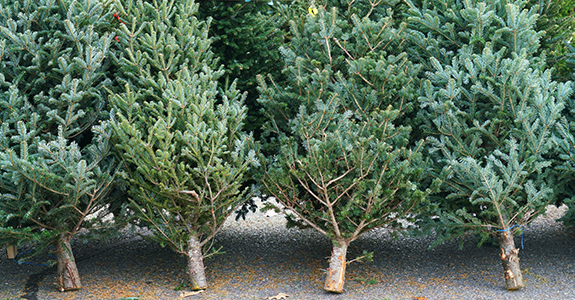Safe handling of Christmas trees will keep the season bright
It's the time of year to harvest firs, pines, and spruce for Christmas. Whether you grow them yourself to sell or have the inventory come to you, it's important to keep safety in mind.
Safely harvest trees
If your customers select their own trees, have your workers cut them down for them. If you allow customers to cut a tree, provide only a manual bow-type saw and supervise the cutting. Trees can be heavy, and if they fall the wrong way—particularly with children present—you could end up facing a significant lawsuit.
If you harvest trees for wholesale, check any pertinent contracts with retailers for hold harmless requirements. Use your sales contract to avoid holding others harmless, or simply cross out any hold harmless language that's written against you if it's in someone else's contract. Once you release your product to retailers, you're not in control of the display or condition. You may not be able to dictate all terms of the transaction, but do your best to protect against consumer claims, and avoid accepting liability or responsibility for the actions or products of others.
Safely display and sell trees
If you sell pre-cut Christmas trees, here are some tips to think about:
Display trees in a safe manner: Trees will be moved around, so have employees available to help move them and check the stands for stability. Make sure empty stands are removed to prevent someone from tripping over them.
Make no assertions: Share industry standards for care and water—but don't make claims regarding safety, freshness at the time of purchase, or how long the trees will stay fresh.
Think about safety: When packing trees for transport, consider all aspects of the journey, from loading on a vehicle to the proper securing for road travel and ease of unloading.
Allowing employees to load trees onto customer vehicles can create liability arguments against you, especially when the customer helps—for example, they may blame your employee for getting poked in the eye, straining their back, or allowing the tree to become unsecured on the trip home and causing a serious vehicle accident.
Preferably, have customers load their own trees, but make sure your employees clearly instruct them how to do it—stump facing toward the front—and provide tie-down materials. Also, have disclaimers regarding any damages incurred during and resulting from the self-loading process and include them on your sales receipt in clear language.
Christmas and coronavirus
Not surprisingly, disruptions caused by COVID-19 are expected to include Christmas celebrations. A survey commissioned by the Christmas Tree Promotion Board shows 92 percent of customers expect the pandemic will change their holiday celebrations. However, that same survey found people were more likely to enjoy simpler, more traditional celebrations—which include real Christmas trees.
Protect your customers
If you sell trees or other holiday items, you'll want to take the proper precautions to help customers feel confident you're taking their safety into account while they shop at your business. Here are some tips to consider:
Recommend customers wear face masks to help protect themselves and others
Sanitize items like countertops, door handles, saws, wagons/carts, scales, and reusable bins and buckets
Employ social distancing
Consider a sign-in sheet by each register for customers to put their name and phone number, so you can contact them if an employee contracts COVID-19
Provide hand sanitizer to customers
Protect your employees
You can also help protect your workers by aiding them in following CDC guidelines. Make sure they know to:
Develop a COVID-19 Plan
Wash hands at least 20 seconds each time, multiple times throughout the day
Require face masks
Avoid touching the eyes, nose, and mouth with unwashed hands
Cover their mouth with a bent elbow when sneezing or coughing and disposing any tissue used, followed by proper handwashing
Stay home if they're sick
Protecting against COVID-19 is dynamic, so consult CDC guidelines and your local experts for guidance.
Protect your business
While Christmas trees seem innocent enough, they come with their share of liability risks. Protect yourself with general liability insurance, vendor agreements, and additional insured endorsements. If you have any questions, want to look at additional coverages, or see what your current policy covers, talk with your Hortica representative.
The information in this article is for informational or entertainment purposes only. View our disclaimer by going to terms and conditions and clicking on Learning Center disclaimer in the table of contents.
